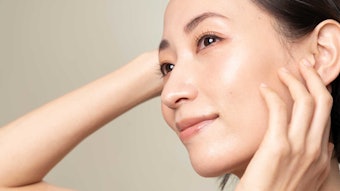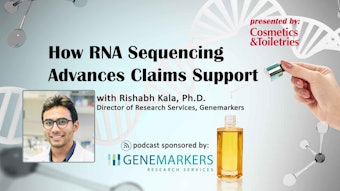
View this article and others in the June 2020 digital magazine.
Perhaps one of the biggest realizations in the field of hair science during the past 10 years is the fact that in real life, hair breakage and damage to the cuticle sheath rarely occur by the action of unrealistic high value forces.
Instead, they occur due to fatigue failure; i.e., from the application of repetitive small forces.1-3 Therefore, previous breakage studies based on the application of single high value forces that extend beyond the hair yield region, i.e., forces > 5 g/fiber, although academically relevant, are less relevant to everyday life. Indeed, fatigue failure is a phenomenon of such great importance that in the field of material science, it has been the object of intense studies for the last 20 years.4, 5
Fatigue failure is a direct manifestation of fracture, a phenomenon explained first by Griffith, who in 1921, discovered that the mechanical force needed to induce mechanical breakage in any material is always much lower than that anticipated based on molecular bonding calculations.6 He found, at the base of this discrepancy, the existence of randomly distributed micro defaults and micro cracks that are always present no matter how perfect the material is.
When a force is applied to a material, the randomly distributed micro defaults and micro cracks act as stress concentrators, causing them to grow further until a large crack develops and breakage occurs. The immediate consequence of randomly growing cracks leading to failure is that a collection of apparently identical materials will always exhibit different breakage force values. Therefore, at best, the breakage behavior of a collection of identical samples can be better described by a statistical distribution.
The molecule interacts with the proteins near the bonding IFs, strengthening the scaffolding structure around them inside the cortical cells.
Griffith also discovered that the micro defaults and micro cracks that act as stress concentrators not only grow by the action of high value forces, but also under the action of repetitive cycling forces of small value; i.e., from fatigue stresses. It is not surprising, then, that fatigue failure is also described by a statistical distribution—one, in particular, known as the Weibull Distribution.7-9
The Weibull equation includes three main parameters that consider observations related to sample survival within the number of fatigue cycles. The three parameters are known as the α, β and γ parameters; α is related to the number of samples that will survive a certain number of fatigue cycles; β describes the shape of the distribution and helps to distinguish the conditions for premature or aging failure; and the γ parameter is a location number.
The three parameters of the Weibull distribution therefore allow for comparisons between failure behavior inferences of samples subjected to multiple cycling stresses under different conditions. In fact, this is one of the two main reasons for using it in the breakage analysis of hair swatches related to this work.
The other reason is, since the point of inception of all catastrophic mechanical failures is always a growing micro crack, and such cracks can exist either at the hair surface or inside the cortex, the method is well-suited for an inside-out evaluation based on small molecules that penetrate across the hair cortex and cuticle. This consideration is of great relevance because under fatigue conditions, a micro crack at the cuticle sheath could potentially grow and cause fiber failure.
By the same token, a micro crack or micro defect located inside the cortex and close to the tip could result in a split end, but also could produce hair breakage. Thus, the inferences made using Weibull statistics and discussed later in this article, in Protect/Repair from the Inside Out, should reflect hair surface and bulk fatigue conditions. It should be mentioned, however, that due to unavoidable hair tangling, sections of hair located at the fiber tips always undergo higher stresses than those further from the tips; consequently, these sections require additional repair and protection. It is for this reason that, in order to design a truly holistic strategy, an outside-in hair repair/protection approach, based on a high molecular weight active and targeting cracks at the hair tips, also is required.
In summary, if one could dissipate the micro-crack energy at the surface and bulk along the hair fibers, and also at the hair tips by using a combination of inside-out and outside-in prevention techniques, not only will crack propagation inside the cortex be halted, but crack propagation from the cuticle sheath at the hair tips also will be avoided. The creation of such a holistic technique, among other potential benefits, will ultimately result in better resistance to hair breakage, less formation of split ends and cuticle sheath protection.
Micro defaults and micro cracks that act as stress concentrators not only grow by the action of high value forces, but also under the action of repetitive cycling forces of small value.
In brief, to provide holistic protection to hair, it is essential to devise hair repair/protection techniques that stabilize the hair structure from the inside out, and from the outside in. The following study will show that such a technique is possible with given cosmetic actives.
Materials and Methods
The hair used for the described experiments was obtained from a third partya. Bleaching treatments were carried out for 60 min with two parts 12% H2O2 to one part bleaching powderb and followed by rinsing and washing with basic 4.5% SLES solution. Hair samples were bleached up to three times.
The test active for inside-out repair comprised a patented blend of hydroxypropylgluconamide (and) hydroxypropylammonium gluconate.10 For outside-in assessments, a microgel was developed via the complexation of two unique copolymers; one anionic and the other cationic, namely: methylvinyl ether/maleic anhydride copolymer (PVM/MA copolymer) and vinylpyrrolidone methacrylamidopropyl trimethyl ammonium chloride (polyquaternium-28), respectively.11
Treatment of the bleached hair fibers was carried out as follows: a 1% active aqueous solution of the test blend was prepared, hair fibers were soaked for 30 min at pH 4 in the solution, then the fibers were rinsed under tap water for 30 sec and left overnight at 50% RH for drying.
Differential scanning calorimetry (DSC) measurements were conductedc and changes in hair’s mechanical performance upon treatment were investigated by cyclic tensile fatigue measurementsd. Measurements utilized an automated hair loading sample, n = 50, and were fitted with a system incorporating a laser micrometere to measure the hair diameter of each fiber. A value of 0.014 g/m2 was selected as the optimum value to ensure a reasonable number of cycles to break—in the range of 1,000 cycles to 10,000 cycles—and still be in the yield region of the stress-strain tensile curve. In order to measure significant mechanical fatigue behavior versus virgin hair, hair first had to be substantially damaged.
As discussed in the introduction, hair breakage data was analyzed using Weibull Statistics. Twenty ATR-FTIR spectra scansf of hair were taken from 700–2000 cm-1 at resolution of 4 cm-1, in addition to Confocal Raman (CR) Spectroscopy Imagingg.
The technique used to induce split-end formation in hair consisted of a systematic process of blow drying, wetting and combing; this technique is described elsewhere.11 After this process, hair tresses were evaluated by means of a stereoscope and a UV fluorescence imaging technique. Hair treatment and preparation methods involving analysis of the actives are described elsewhere.9
Results: Validating the Weibull Method
For the sake of clarity, the following discussion and description of experimental data is divided into two sections. The first relates to effects of strengthening hair from the inside out using the patented molecule described previously; namely hydroxypropylgluconamide in equilibrium with hydroxypropylammonium gluconate. The second relates to outside-in effects of a polymer microgel.11
Before making any analysis, however, and in order to increase confidence in the chosen statistical approach, it is necessary to assess the range of validity of the Weibull statistical method. For this purpose, Weibull statistic results from various hair samples were first compared with another estimation technique known as the Kaplan-Meier method. Figure 1 shows statistical values derived from the effects of bleaching treatments of hair batches with no active treatment and by both techniques.
This clearly shows that the Weibull survival parameter α and the Kaplan-Meier parameter provide estimations that agree with common sense real observations; namely, that the breakage survival probability of fibers during fatigue decreases significantly with the number of bleaching treatments. This also is an indication that as the number of hair bleaching treatments increases, the internal structure of the hair cortex becomes weaker. These preliminary observations therefore confirm the validity of the Weibull technique for the present analysis.
Results: Protect/Repair from the Inside Out
The results of the inside-out repair/protection effort by the test active are depicted in Figure 2, which show Weibull plots from fatigue testing of hair samples with and without the hydroxypropylgluconamide treatment. The plots depicted demonstrate survival percentages as a function of number of cycles for virgin, 2× bleached and 3× bleached hair.
In Figure 3, again, for the sake of confirmation, the Weibull parameters are compared with the Meier-Kaplan estimation parameters for the samples described in Figure 2. Both methods show a close agreement in prediction parameters. In fact, upon close inspection, Figure 2 and Figure 3 show that the hydroxypropylgluconamide molecule is indeed capable of increasing both the Weibull α characteristic lifetime and the β shape parameter for both the 3× and 2× bleached hair controls. These observations suggest the test ingredient works from the inside out, hindering the process of crack growth and propagation inside the cortex during cyclic fatigue, ultimately resulting in less hair breakage.
The scientific literature has shown that increased Td increments in hair are associated with higher levels of intermediate filament (IF) stabilization.
In order to gain a deeper understanding of the mechanism by which the ingredient acts inside the hair cortex, fiber analysis was carried out using DSC and Confocal Raman Spectroscopy and ATR-FTIR. Figure 4 shows DSC data depicting the variation in hair denaturation temperature (Td) as function of pH after hair samples were immersed in various solutions containing hydroxypropylgluconamide. Here, it is clear that for each pH value, the active was able to increase the Td value beyond that of the respective control at the same pH. The greatest difference was recorded at pH 4, which is therefore the recommended application pH to achieve optimum hydroxypropylgluconamide benefits.
Indeed, the scientific literature has shown that increased Td increments in hair are associated with higher levels of intermediate filament (IF) stabilization.12 Here, the significantly increased Td values (see Figure 4) observed after damaged hair was treated with hydroxypropylgluconamide indicate the molecule interacts with the proteins near the bonding IFs, strengthening the scaffolding structure around them inside the cortical cells. This leads to a hair structure with higher resistance to crack propagation.
Similar observations confirming the DSC analysis were obtained from Confocal Raman Spectroscopy. These are depicted in Figure 5 and show, for example, a loss of alpha peak at 1,652 cm-1 for untreated samples, indicating a loss of helical proteins in untreated rather than treated hair fibers.
Based on this data, a mechanism is proposed in Figure 6 that describes the interaction of hydroxypropygluconamide with the hair IFs.13 Further analysis by FTIR-ATR of hair samples treated with the test active also strongly support this proposal: namely that the active interacts with the proteins by surrounding the IFs and thereby stabilizing them against crack growth.
For instance, the ATR-FTIR spectroscopy data displayed in Figure 7 shows there is less damage in hair fibers treated with hydroxypropylgluconamide. This effect is evident in Figure 7, where it is observed that the peak value at 1,076 cm-1, obtained from 2× bleached hair treated with the test active, is of lesser magnitude than that observed for the counterpart hair fibers that were not treated. The peak at 1,076 cm-1 is due to the appearance of S=O groups, which are produced as the disulfide bonds S-S in the hair matrix become oxidized during bleaching. The fact that the peak value of the S=O groups decreases after the 3× bleached hair was immediately treated with hydroxypropylgluconamide indicates this active may indirectly induce bond rearrangements in the hair matrix.
Results: Protect/Repair from the Outside In
Results for hair treated with the test microgel for an outside-in approach demonstrated that the formula prevented further crack propagation, in turn preventing potential hair breakage. Figure 8 shows the results of a technique used to assess split end repair. This approach is based on the fact that split ends fluoresce when illuminated by UV light, which is useful to assess split end intensity and count the number of split ends in hair tresses.
Counting the number of split ends in hair treated with the microgel, researchers calculated the level of repair using the formula: % Repair = 100×(A-B)/A, where A is the average number of split ends counted before treatment and B is the average number of split ends after microgel treatment and combing. Thus, according to the formula, if the average number of split ends before and after treatment is not significantly different, the percentage of repair is zero. However, if the B value decreases significantly, then a positive number in % Repair is obtained. It should be mentioned here that the average number A of split ends was controlled and represents the number of split ends created intentionally at the start of the experiment; more details on this method can be found elsewhere.11
Figure 9 shows the percentages of split end repair obtained using this counting technique from five hair tresses treated with a prototype formulation containing the microgel. Here, the percentage of split end repair obtained with the test microgel was high, reaching nearly 90%. As the same figure shows, however, after hair combing, the percentage of repair is somewhat reduced, indicating a certain fraction of the split ends reappeared—although not to the level of zero repair.
Optical and SEM microscopy images of hair fibers tagged for their identification are shown in Figure 10. These show the state of split ends before and after treatment with the microgel. It is apparent that the level of split-end mending is almost complete. Furthermore, the SEM caption in the same figure shows that the cuticle sheath has been smoothed by the action of the microgel. A mechanistic explanation of the events leading to split end repair by the microgel is found in Figure 11; here it is shown schematically that the polyelectrolyte complex penetrates either into an open split end or into micro cracks before they propagate and become a split end.
The involvement of micro cracks in the formation of split ends is a direct consequence of high mechanical stresses acting at the cortex and cuticle sheath, and this has been the object of studies by other authors.3, 13 Its repair therefore most certainly involves strengthening the cuticle and cortex structure at the tips to resist micro-crack growth. Once the microgel, with positive and negative charges, penetrates in the micro cracks, it forms salt linkages with the proteins inside the crack. This phenomenon turns the microgel into an adhesive film that, once dried, contracts closing and mending the split end.
The polyelectrolyte complex penetrates either into an open split end or into micro cracks before they propagate and become a split end.
Conclusions
The series of observations described herein clearly demonstrate two things. First, it is possible to prevent crack propagation in the hair cortex and increase the resistance of hair to cyclic fatigue by reinforcing the bonding structure of the IFs. Such a benefit in hair can be attained using an inside-out, strengthening strategy involving hydroxypropylgluconamide. Second, cracks in the cuticle sheath and cortex at the hair tips and in open split ends can be mended or closed by using an outside-in repair strategy, such as the described polymeric patented microgel.
Finally, since these two modes of action are straightforward, the use of both ingredients, either separately or in combination, could lead to a substantial reduction in hair crack propagation from the inside out, and outside-in (data not shown). Crack formation and propagation is one of the most deleterious forms of mechanical hair damage that invariably results in unwanted physical damage. Thus, the most important feature of both of these approaches is their effects can benefit the entire hair fiber, holistically.
References
1. Evans, T.A. (2010). A statistical analysis of hair breakage. II. Repeated grooming experiments. J Soc Cosm Chem 61 6 439-456.
2. Evans, T.A. (2009, Nov/Dec). Fatigue testing of hair—A statistical approach to hair breakage. J Cos Sci 60 599-616.











